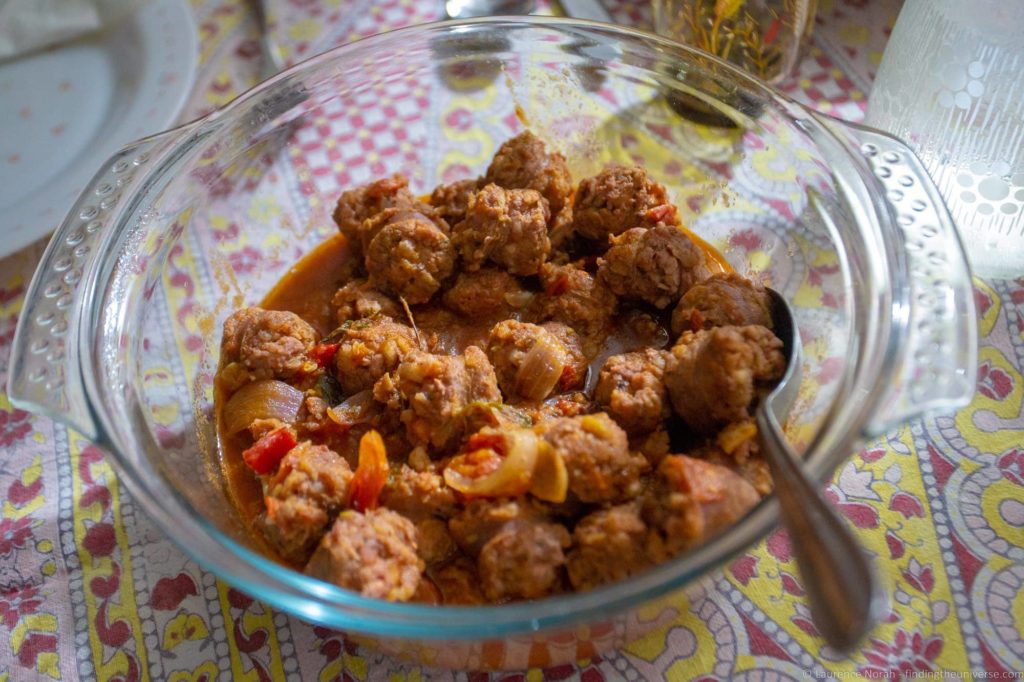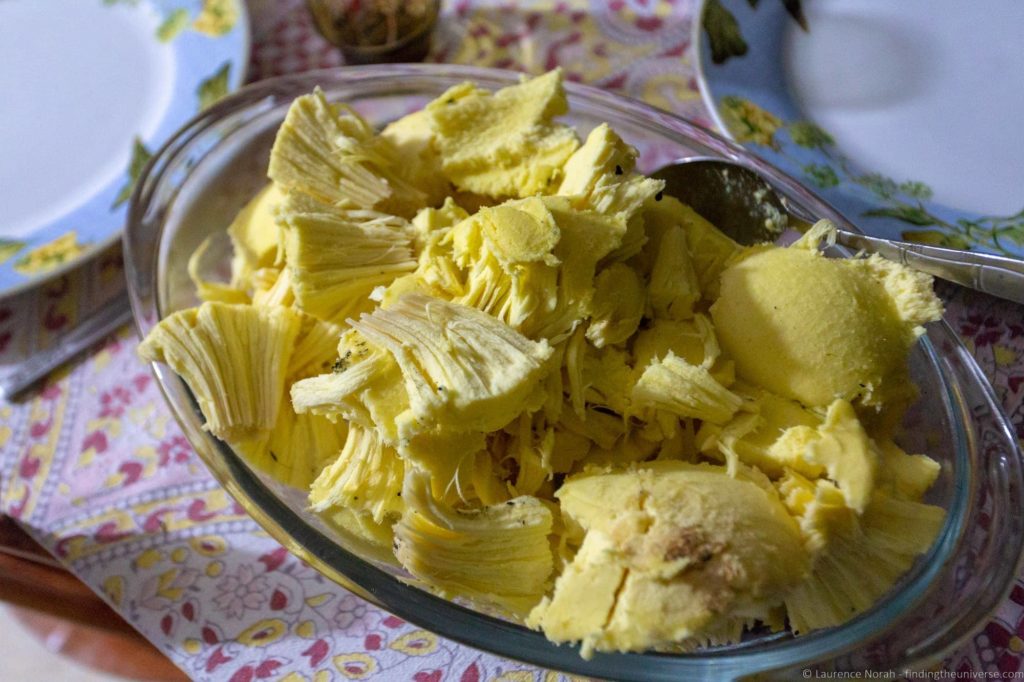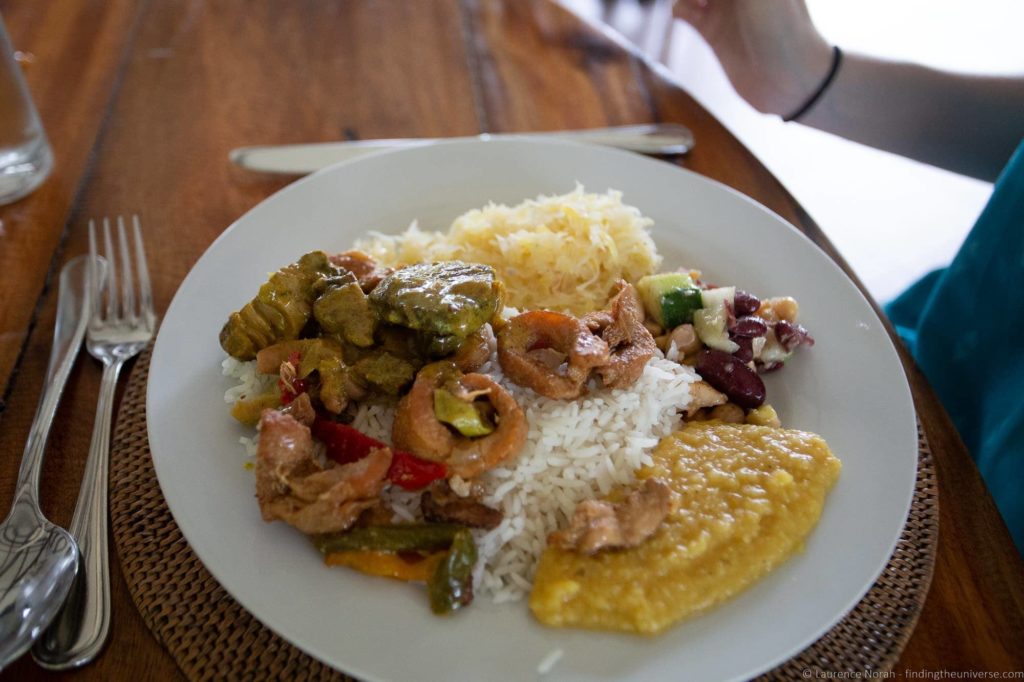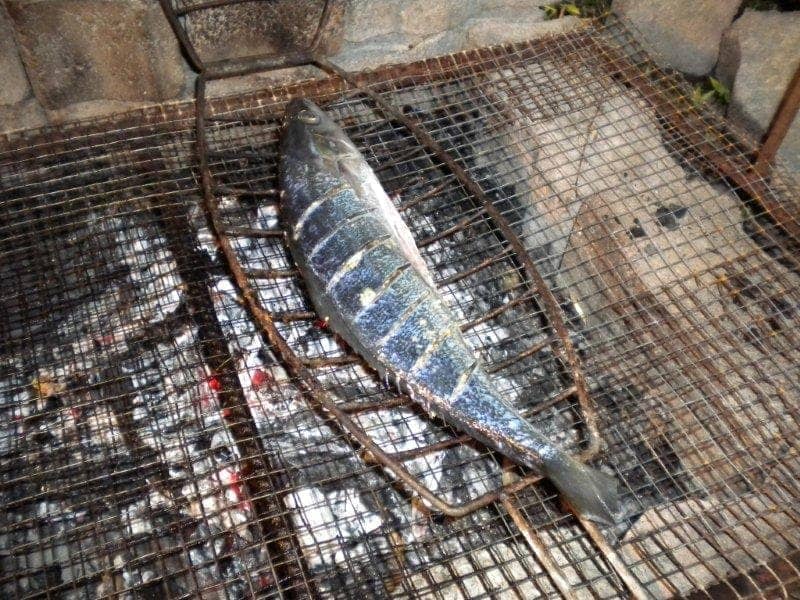The Seychelles islands are known for a number of things. Right at the top of most peoples’ list would be the beaches, what with their turquoise warm waters, brilliant white sands, palm trees and, well, you’ve got the idea.
Another thing most visitors to these islands fall in love with is the Seychelles food. And there’s good reason for that. From freshly caught fish, to locally grown fruit, from spicy curries to sweet fried bananas, there is something here for every taste bud and palate.
I am lucky enough to be part Seychellois, and have spent a significant part of my life on these wonderful islands. My granny and aunt both made some pretty spectacular traditional Creole dishes, and it was always a pleasure to dine in their kitchen.
Here, in no particular order, are some traditional Seychelles foods you should try out when you hit the islands!
Traditional Seychelles Food
1. Fresh grilled fish
The Seychelles is home to a countless number of tropical fish species, which local fisherman will sell to you, either from the market in Victoria, or by the side of the road fresh from the boat. Listen out for the sound of a conch shell being blown – the traditional sign that fish has just been brought ashore for sale.
One of the most popular ways to prepare a fish is over the hot coals of a BBQ, often fired by coconut husks to give a wonderful aroma and flavour to the fish.
Usually preparation of the fish is minimal – just some slits down the side into which garlic, ginger and chilli is stuffed – and then grilled to perfection. Barracuda in particular are excellent done in this style.
2. Salted fish
Salted fish, or Pwason Sale, as the locals call it, is less common today than it used to be, but it is still available if you know where to look. Again, the lack of refrigeration until well into the late 20th century meant that food preservation was a challenge, so to keep produce edible all sorts of preservation techniques were used, including pickling and salting.

Salted fish (Poisson Sale in French) is pretty much what you would imagine it to be – fish is liberally covered in salt and then left to dry in the sun. When you want to cook it, you soak it for a while, drain some of the salt out, then use it as you would any other ingredient.
I’m not going to lie to you – this is what could be described as an acquired taste. The taste is both incredibly fishy and incredibly salty at the same time. If you’re into anchovies, you will probably be in heaven. If you hate anchovies.. well.. perhaps go for the curry.

There are a variety of ways that salted fish can be served, but the absolute classic has to be the Rougay. This is basically just a tomato and onion base with plenty of garlic, ginger and chilli, fried up, then served with rice. Another excellent option, which cuts through some of the salt, is to have it as a coconut curry.
3. Coconut Curry
When my Mum moved out to the Seychelles way back in the seventies, she started out her culinary adventures by asking my Dad how they cooked things. She relates that she soon gave up asking the question because the default answer was invariably curry.
And curry really is a dish that your average Seychellois adores. This could be something to do with the history of the islands – electricity arrived late – so spices were used as a preservative. Whatever the reason, curry, often based around masala spices, curry leaves, hot chillies and lots of freshly made coconut cream, is a staple.

The ingredients vary, back in the day bat and goat were key ingredients, although you may struggle to find those today. Instead, chicken and fish curries are likely to be on your plate, with Octopus Curry a local Seychelles speciality you should definitely try at least once.

Enjoy, but do watch out, because the Seychellois do like their curries hot!
4. Lentils
An often overlooked dish, but a critical side component of a traditional Seychelles curry feast is the humble lentil. In Seychelles, red lentils are a popular staple, served as a side dish with many dishes. These are often cooked for a long time with garlic, onion and ginger, with the result being a fairly yellow paste.

This might not look hugely appetising, but it is very tasty. Definitely add some to your plate if you have the choice to do so!
5. Sausage Rougay
One of my all time favourite dishes is “sosis rougay”, or sausage rougay. This is a sausage based dish (as the name suggests) in a rich tomato and onion sauce, which usually also features garlic, ginger and chilli.

The secret to a fabulous sausage rougay though is the type of sausage. Ideally, this dish will be made with local coarse cut salted sausage. This is a little bit like a Tuscan sausage in texture, but a lot saltier, and gives the dish it’s signature flavour. Rougay can also have other ingredients – a salted fish rougay is another favourite Seychelles food of mine!
6. Anything with banana in
The Seychelles, at last count, is home to at least 23 different banana species. From tiny little sweet bananas, to giant plantains that need to be cooked, there is a banana size for everyone. And once you’ve tried a recently plucked banana you will wonder how you ever coped with the supermarket variety back home.

Bananas are used as a key ingredient in a number of dishes, most notably, desserts. Bananas fried with sugar and butter are a favourite of mine, resulting in a giant, sticky, toffee like mess. Bananas baked with coconut milk and sugar are another classic, the so called Banann ladob. You’ll also find them flambeed with rum or brandy, fried as chips, and of course, just served as they come. Delicious in every way!
6. Breadfruit
Breadfruit is a remarkably versatile food ingredient, basically imagine it as a giant potato in terms of cooking flexibility. So you can boil it, bake it, mash it and fry it. It can even be cooked in coconut milk and sugar as a dessert option, and breadfruit “ladobe” is a classic Seychelles dessert.

In my opinion though, by far the best way to eat breadfruit is to just put it whole (they are fairly large), with the tough skin on, into the embers of your fire, surrounded by coconut husks, leave it for around 45 minutes, and when the skin is charred, crack it open to reveal the steaming creamy white flesh within.
Traditionally, you would then lather it with pork lard and salt and chow on down, but these days people find butter to be a more than acceptable substitute. And don’t forget the Creole saying – if you’ve eaten breadfruit in Seychelles, you are guaranteed to come back to the islands!

7. Smoked Fish Salad
As you would imagine, the Seychelles has a lot of fish! One popular and traditional way of preserving fish, particularly before the advent of refrigeration, was to smoke it. Smoked fish has a wonderful flavour, and it works particularly well in a cold salad.

This can be served with a variety of vegetables with a dressing, and the fish is usually a larger fish with darker meat, like swordfish, sailfish or tuna. It’s also popular to use unripe fruits such as mango or papaya in the salad, which adds a tangy zest to the dish.
8. Traditional “Satini”
In the Seychelles a “Satini” is a sort of salad, which consists of finely grated ingredients. This is commonly made with either unripe fruits, such as papaya or golden apple, and mixed with spices and onions. It can also have quite a lot of chilli in, so do beware.

Satini can also be made with fish, most commonly shark, and it will usually be yellowed with turmeric spices and look like finely ground meat. Ground coconut is another popular ingredient. In the image above, you can see papaya satini at the top of the shot, and lentils at the bottom.
9. Fresh Fruit
Being a tropical paradise, you would think that Seychelles would be blessed with oodles of fresh fruit. And you would be right! There’s all sorts of fresh fruit on offer, including mango, papaya, avocado, banana, starfruit, coconut, limes, grapefruit – the list goes on!

Fruit is easy to come buy and pretty cheap to boot, so this is a great way to snack through the day. Fruit is nearly always served as a breakfast item, but you won’t have much trouble finding it throughout your stay in the Seychelles.
10. Traditional Seychelles Snacks
Speaking of snacking, if you find yourself getting hungry, there are a number of traditional Seychelles snack foods that you should try. These can be bought at most corner stores or supermarkets quite easily and cheaply.

Three of the more popular snacks are banana chips, breadfruit chips and “molouk”. The former are deep-fried and salted snacks, much like potato chips (crisps if you’re British). The latter is basically deep fried bread dough.
Sure, none of those snack options are exactly healthy, but they sure are tasty! If you want a slightly healthier, not deep-fried option, coconut is a popular snack option too!
Where to eat Traditional Seychelles Creole Food
I’m very lucky, because I got to grow up in the Seychelles, and with family out there, I have had traditional Creole dishes cooked for me by people who have spent a lifetime cooking delicious Seychelles food.
Don’t despair though – as a visitor to the Seychelles, you have a number of options for trying traditional Creole food.
1. At a locally owned guesthouse
One good option we’ve found for eating locally made Seychelles food is at a locally owned guesthouse or self-catering property where the owners offers meals as an optional extra.
We stayed at two properties in the Seychelles, both self-catering, where we were able to order food for dinner. In both cases, this was absolutely delicious and definitely authentic.
The two properties we stayed at which offered this service were Villa Kordia on Mahe and Oceane Self Catering on La Digue. It’s definitely worth checking to see if the property you are staying at offers home cooked meals as an option, and reading through the reviews to see what other visitors have to say about the food.

2. At a Creole restaurant
Your next best option for a good Creole meal is to go to a restaurant that specialises in Creole food. Whilst there are many places to eat out in the Seychelles, you want to go somewhere that has made a name for itself as a good place to eat.
There are a number of restaurants that fit this bill. On Mahe, the most popular and longest established is Marie Antoinette. Found in the capital city of Victoria and situated in an old Creole house, this restaurant has been serving up traditional Creole meals for many years.
The menu is fixed, and you get a variety of smaller dishes, meaning you get to sample a variety of traditional Seychelles foods at a relatively inexpensive price. Reviews are a little mixed – our advice is to go earlier on in the seating times, to ensure you get the food when it has been freshly made. We really enjoyed our meal here when we went in April 2018.

If you like seafood, then you’ll find a nice restaurant on the beach front at Anse Lazio on Praslin – Bonbon Plume. Whilst this is a little on the pricey side, the basic Creole dishes like fish curry are reasonable priced, and the grilled fish we had here was some of the best we ate on our trip.
3. At your hotel
The majority of hotels you are likely to stay at will likely offer some form of Seychelles food as an option – with the quality and value varying from property to property.

Of course, there are some hotels where you’ll be served fabulous food, and others where it will be westernised beyond recognition. But hopefully, with the choices I’ve given you, you’ll still be able to find the traditional flavours of the Seychelles when you visit!
And that’s it for my guide to some of the best foods in the Seychelles that you have to eat when you visit these stunning islands. Next up, you should check out our guide to spending 1 week in the Seychelles to give you more ideas for your trip, as well as our guide to the best beaches in the Seychelles.
As always, if you have any questions, don’t hesitate to let us know in the comments below!




John Dede says
Your site is excellent and useful…So are you currently living there(Seychelles)? I was planning to visit before next year for both business and leisure ..i hope you will have useful tips to make my trip easier and worthwhile
Laurence Norah says
Hi John,
Thanks very much! We’re not currently living in the Seychelles, although I have lots of family out there and try to visit regularly 🙂 If you want some tips, I have a much longer post about visiting which you can see here: https://www.findingtheuniverse.com/visiting-the-seychelles-a-1-week-seychelles-itinerary/
Have a lovely trip, and if you have any specific questions of course I will do my best to help out 🙂
Laurence
Lucile says
Hello, I am a Seychelloise who grew up cooking and enjoying our creole cuisine. My grandmother taught us to cook some older dishes so I have multigenerational knowledge of the cuisine.
Most of what you have written is correct and interesting however there are a couple of inaccuracies.
Smoked fish is a relatively new dish in Seychelles. It has only been around for the last 30 years or so and did not come about through lack of refrigeration. It is plausible that a few people might have smoked fish a hundred or so years ago before the availability of refrigeration but it was certainly never a part of the wider cuisine then.
You also talk of bat and goat curries. I am aware that some people eat bat in Seychelles and again this has never been a widespread part of the cuisine. Same for goat. Goats are not animals that are commonly kept or eaten in Seychelles.
Laurence Norah says
Hi Lucile,
Thanks very much for your comment and clarification. I did not realise that smoked fish wasn’t a big part of Seychellois cuisine until recently. I know my Dad grew up in the Seychelles and regularly ate bat and goat curry, so it is interesting to hear that that was not a common meal across the islands. I love goat curry but haven’t had bat very often, so the jury is still out on that one.
Thanks again for stopping by and taking the time to comment, it’s much appreciated,
All the best,
Laurence
Andy from Taiwan says
Hello Mr. Laurence,
I just wanted ask you if you have recipe for coconut curry. I really enjoyed post– really was entertaining! I have cook one seychellois dish for school project. hoping for good luck! Thanks so much!
Laurence Norah says
Hi Andy!
Thanks very much. i don’t personally have a recipe for coconut curry, but a friend of mine runs a website dedicated to Seychellois recipes which you might find helpful! There isn’t a coconut curry for chicken, but there are coconut curries for other meats and fishes, which could easily be adapted I think 🙂
https://www.thecreolemeltingpot.com/category/main/
Enjoy – let me know how it turns out!
Laurence
La says
Very difficult to find fresh fruit and vegetables. Food is expensive here too.
Laurence Norah says
This is definitely true – being an island nation means many things have to be shipped in at quite some cost, which adds to the overhead. if you can find local fruits and vegetables they might be better – I was always lucky that my family had various fruit trees in the gardens!
Rose-Marie Gandini says
Just returned from a 2 week holiday. Stayed at a guest house and treated like one of the family. The only thing that bothered me was the heat. Make sure you stay at a place with air conditioning.
Laurence Norah says
Hi Rosie-Marie,
Glad to hear you had a great time in the Seychelles! Getting an experience with a local family is hard to beat, I am lucky in that I have family in the Seychelles, and I love visiting because they make all my favourite foods. They’ve also recently installed air conditioning, I have to agree, it’s a must!
Thanks for your comment!
Laurence
Salam AH says
HI Lawrence
looking for a dish made in Seychelles but cant get the recipe, maybe you can help
vegetable (squash, french beans..) cooked with coconut milk and fried fish
thnks
Salam
Laurence Norah says
HI Salam,
It sounds like a variation on a fricasse like this: https://lakwizinsamadanm.blogspot.com/2014/04/pumpkin-fricassee.html?fbclid=IwAR0EJWt4gtLU85kpBDwJtV6eQwt5IJMuvFxbwTKOC4B9E-mxxH4LNuTqhk0
But with added coconut milk perhaps? It could also be a curry. It doesn’t sound like a specific dish, rather probably a variation on a coconut curry / fricasse.
Sorry not to be of more specific help!
Laurence
MANOJ says
Hi Mr.Laurence,
Greetings from India…!
I am Indian belong to the state of Kerala ( malayalee ).
As you rightly pointed out ” molouk ” seems to be the Seychellois version of
” murukku” from Kerala.It is made out of dough made out of rice and gram flour with added red chilli powder and sesame seeds strained through a manual press with sieve of various shape and it is deep fried.addition of rice flour make it crispy.,It is a common and favorite evening tea snack for children in South India.
Dr.K.S.Manoj
Laurence Norah says
Thank you very much for the clarification Dr Manoj 😀 I will have to come to Kerala and try out murukku 🙂
Scarlett says
I’ve been a vegetarian for close to 30 years, though I do eat a little bit of fish/shrimp. And I have a chili intolerance. Any hope of finding something to eat on the islands?
Laurence Norah says
Hi Scarlett,
You should be ok, certainly not all Creole food is spicy or with meat 🙂 There are also plenty of non-traditional foods available on the islands!
Have a great trip 🙂
Laurence
Richard cam says
You forgot cassava crisps, by the way my mum is from the Seychelles, I can’t wait to retire there
Laurence Norah says
An excellent point! I love Cassava crisps 🙂 Enjoy your retirement in the sun when it comes!
oluwakemi says
Hi everyone, am oluwakemi from Nigeria, I want information about living and working in seychelles. Can I get help from here
Laurence Norah says
Hi oluwakemi
To be honest this isn’t the right place as this blog is more for people looking for holidays in Seychelles. You would likely need to look at the official Seychelles government website for advice on living and working in Seychelles: http://www.ics.gov.sc/working-in-seychelles
Good luck!
Laurence
Ruth says
Thank You for this. Seychelles is also a great place to live and work
Laurence Norah says
I agree – I lived in the Seychelles for many years, and my parents lived out there also and worked for a long time 😀
Richard Miles says
Hi
Interesting article, many thanks. We just got back from two wonderful weeks in Seychelles.
You mention “molouk” as a snack and I think you are referring to a fried, crisp, round (like really thick spaghetti) spiced snack that we enjoyed most evenings but never knew what they were called. I can’t find a recipe anywhere online, any ideas?
Thanks.
Laurence Norah says
Hi Richard! This is a great question. I’ve always just bought it, so I’m not sure how you actually make it. However, I’ve reached out to my friends and family in the Seychelles to find out if anyone knows how to make it and I’ll let you know what they say!
Richard Miles says
Thanks, will look forward to ideas.
I’m guessing a spiced soft yeast risen dough forced through some type of noodle press into a deep fryer.
My kids will be so impressed if I can make them as they enjoyed as a pre dinner snack throughout our stay.
Laurence Norah says
Hi Richard!
So the bad news is that everyone in the Seychelles I’ve asked about this is perplexed, because they just buy it from the store. However, I have been doing some research as to where it might have orignated, and because it was traditionally found in stores owned by Seychellois of Indian descent, I think it is likely actually the Indian snack Murukku (https://en.wikipedia.org/wiki/Murukku), and the name has just changed a bit.
Particularly if you look at the image on that page, you can see there are a number of ways this can be made, and one of them looks very similar to the version you find in Seychelles:
https://en.wikipedia.org/wiki/Murukku#/media/File:Muruuku.jpg
There are a lot of recipies for Murukku online, I’d suggest finding one that looks achievable and seeing how you go! Hope this helps 🙂
Richard Miles says
Thank you very much.
I had the same feeling about Indian descent because of the flavours and as you say, sold in all the Indian owned stores.
Loads of recipes come up now so I am going to be very popular in our house.
Many thanks for your help with this.
Kind regards
Richard
Richard Miles says
Hi Laurence
Okay, my first attempt at Murruku turned out unbelievably well and was very close to the snacks enjoyed in Seychelles. Here is the recipe that worked for me –
Murukku
1 cup Gram flour
1 cup rice flour
1 tbsp unsalted butter
1 tsp salt
1 tsp cumin seeds
1 tsp ground cumin
1/2 tsp ground cinnamon
1/2 tsp chilli powder (or more!)
Mix
add
3 tbsp very hot oil
Mix
Add
2/3 cup hot water (gradually to form soft dough)(may need more or less)
Press through noodle maker (or Murukku maker) into hot (170c) vegetable oil.
Fry both sides until fizzing dies down.
My noodle press holes were slightly too small so produced slightly thinner murruku but, hey.
Many thanks for your vital input to this little success story.
Laurence Norah says
That is brilliant news! I’ll be sending this to all my Seychelles family so they know too 😀